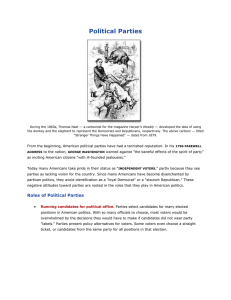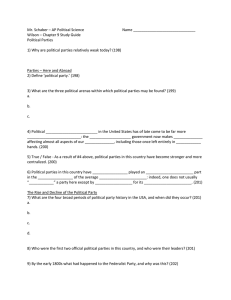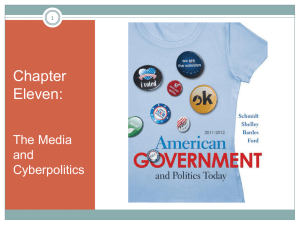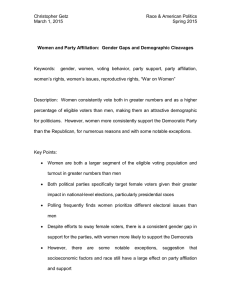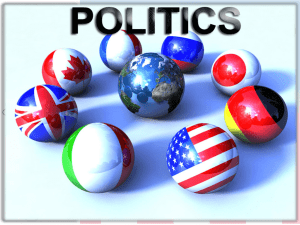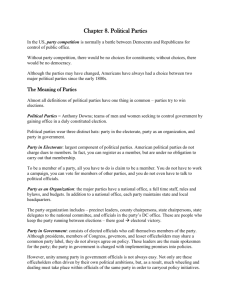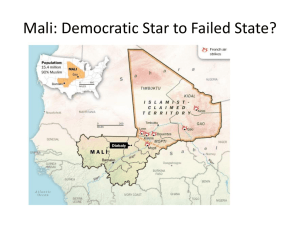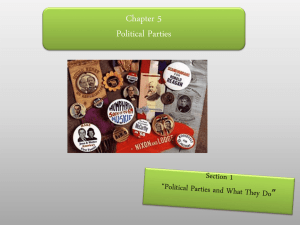American Government and Politics Today
advertisement
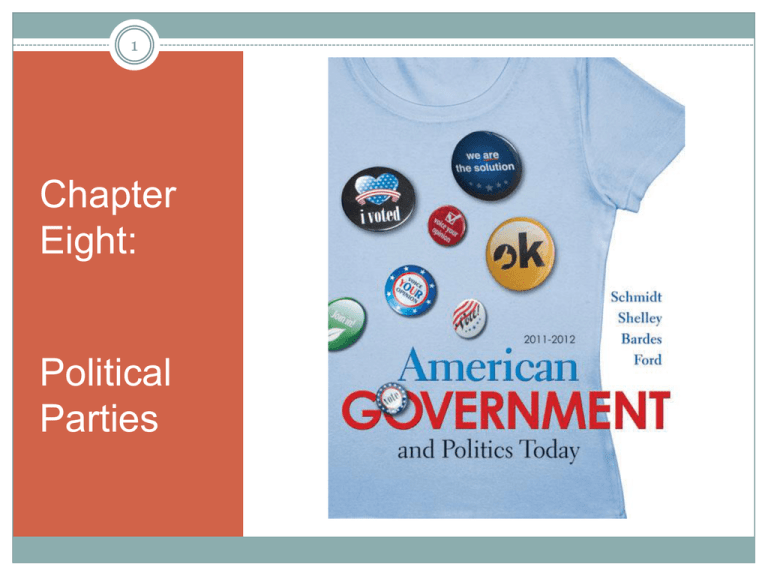
1 Chapter Eight: Political Parties Learning Objectives 2 Distinguish between a political party, an interest group, and a faction. Identify the primary functions of a political party. Identify and explain the significance of the distinct eras of political party development. Learning Objectives 3 Explain the transformation of the Democratic Party from a party of limited government, states’ rights, and racism to a party of strong government, national authority, and support for civil rights. Describe the core constituents and economic beliefs of the Republican and Democratic parties today. Learning Objectives 4 Explain how economic politics and cultural politics often pull individual voters in different directions. Explain the three faces of a political party: the party organization, the party in electorate, and the party-in-government. Explain how the winner-take-all election system works against third parties. Learning Objectives 5 Compare and contrast ideological third parties and splinter parties. Explain what partisan realignment is and identify the four most important realignments in American history. Briefly explain the rise of independent voters and split-ticket voting. Define the concept of demographically based political tipping and give one contemporary example. What Is a Political Party? 6 A political party is a group of political activists who organize to win elections, operate the government, and determine public policy. What Is a Political Party? 7 Political parties differ from interest groups: do not want to operate the government. do not put forth political candidates. interest groups tend to sharpen issues, while political parties tend to blur their issue positions to attract voters. What Is a Political Party? 8 Functions of Political Parties Recruit candidates for public office Organize and run elections Present alternative policies to voters Accept responsibility for operating government Act as organized opposition to party in power A History of Political Parties in the United States 9 The Formative Years: Federalists and Anti-Federalists The Era of Good Feelings National Two-Party Rule: Whigs and Democrats A History of Political Parties in the United States 10 The Civil War Crisis The Post-Civil War Period “Rum, Romanism, and Rebellion” The Triumph of the Republicans A History of Political Parties in the United States 11 The Progressive Interlude The New Deal Era A History of Political Parties in the United States 12 An Era of Divided Government: From 1968–2010, the general pattern was often a Republican president and a Democratic Congress. 2000 Presidential Election (Red state–blue state) The Two Major U.S. Parties Today 13 Economic beliefs: Democrats are associated with improving the environment, education, energy problems, and health care. Republicans are associated with dealing with terrorism, and solving the budget deficit. The Two Major U.S. Parties Today 14 The Two Major U.S. Parties Today 15 The Two Major U.S. Parties Today 16 Cultural Politics and Socioeconomic status: lower income people tend to be socially conservative. The Regional Factor in Cultural Politics: wealthier regions tend to support Democrats. The Three Faces of a Party 17 Party-in-the-Electorate Party Organization Party-in-Government The Three Faces of a Party 18 Party Organization National Party Organization: National Convention and Delegates National Committee National Chairperson State Party Organization Local Party Organization The Three Faces of a Party 19 The Three Faces of a Party 20 The Three Faces of a Party 21 Party-in-Government Divided Government The Limits of Party Unity Party Polarization Why Has the Two-Party System Endured? 22 Historical foundations of the system Political socialization and practical considerations The winner-take-all electoral system State and federal laws favoring the two-party system. The Role of Minor Parties in U.S. Politics 23 Ideological Third Parties Splinter Parties The Role of Minor Parties in U.S. Politics 24 The Role of Minor Parties in U.S. Politics 25 The Role of Minor Parties in U.S. Politics 26 Impact of Minor Parties Influence the Major Parties Affect the Outcome of an Election Mechanisms of Political Change 27 Realignment: major constituencies shift their allegiance from one party to another. Dealignment: increase in independent voters. Tipping: a group becomes more numerous over time and changes the political balance. Mechanisms of Political Change 28 Web Links 29 Democratic Party: www.democrats.org Republican National Committee: www.rnc.org Libertarian Party: www.lp.org Green Party of the United States: www.gp.org Politics1.com Offers information on major U.S. parties and 50 minor parties: www.politics1.com/parties.htm What If…Parties Were Supported Solely by Public Funding? 30 Today’s major political parties are supported by hundreds of millions of dollars offered by unions, corporations, other groups, and individuals. If funding was reduced, it would reduce the effectiveness of political parties. Individuals, corporations, and interest groups could not contribute. What If…Parties Were Supported Solely by Public Funding? 31 Possible effects: Could reduce lobbying Could lead to the growth of nonparty organizations Could increase candidate fundraising. Could lead to new, smaller political parties
